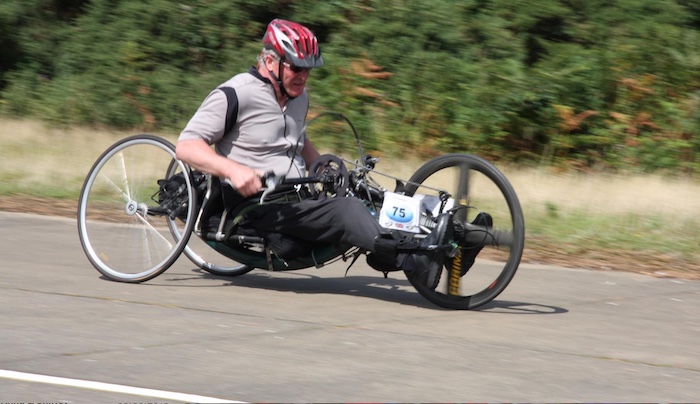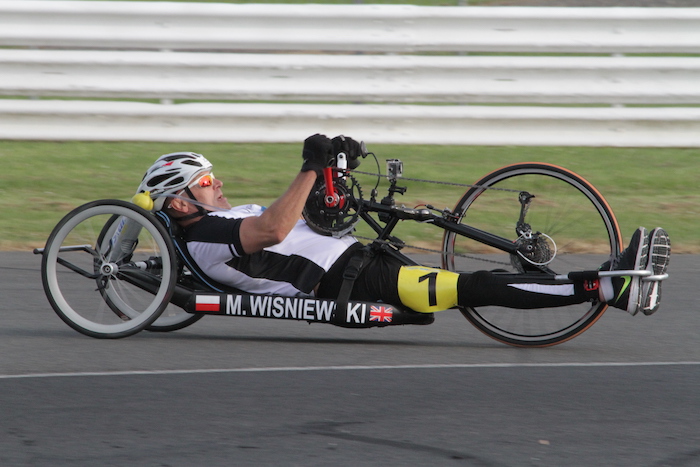You can download this as a factsheet  .
.
[Please note the factsheet does not contain the following: You should not have to pay VAT if your cycle is adapted for disabled users. Even a bicycle may be eligible to be VAT free. More information ]
Who is this factsheet for?
This factsheet is for health professionals supporting people primarily with limited lower limb motor function e.g. people with spinal cord injury or a neurological disorder affecting mobility and limb use, such as Multiple Sclerosis, or post-stroke. In reality however, individuals with a wide range of physical or mental health conditions can enjoy using the cycles described below, as they can be adapted to suit a wide range of orthopaedic restrictions and hand impairments. There are other non-standard cycles available for people with limited upper limb mobility which are not included here.
The fact sheet “Inclusive cycling: getting started” provides additional relevant information to support people to start, re-start or keep cycling and includes links to the UK’s over 40 inclusive cycling hubs.
This factsheet covers:
Why cycle?
Cycling is an activity that provides health and wellbeing benefits, but people cycle for many reasons. These include cycling for leisure, transport, fitness and competition (not covered here), and in different environments, such as in parks, on traffic free routes, on racetracks or on roads.
The person’s objectives may alter when faced with changes to their mobility, and these will need to be explored when considering what kind of cycle best fits their needs and abilities.
There is anecdotal evidence that wheelchair users are perceived more positively by the general public when cycling to get around rather than when using a wheelchair.
Cycling is easier than walking for some and the Department for Transport is now considering the feasibility of including cycles as a mobility aid, like wheelchairs.
Cycle types
Below are the main types of cycle that give a flavour of what’s possible, all of which can also be e-assisted. This means that the cycle is fitted with a battery to assist in providing some power whilst the person is pedaling. When a speed of 25 km/h is reached the battery cuts out and the power is provided from the cyclist alone.
More information can be found at Disabled Gear and a supplier-created site Handcycling.co.uk.
The person’s physical and cognitive ability and motivation will determine their level of independence and the amount of effort required to cycle.
| Clip-on attachments
These can be the cheapest type to buy for a rigid frame wheelchair user. Here, Isabelle is using a clip-on attachment, creating a handcycle. This can either require a docking unit or clip directly to the frame. Her cycle also has an electric battery. An important advantage in using one’s own wheelchair is the ability to retain the right posture, especially if the chair is bespoke. Additionally, the wheelchair is automatically at the other end of the journey so there is no need to transfer. |
|
| Upright hand cycle
These cycles have a similar position to most wheelchairs with good back support, whilst maintaining a posture that reduces pressure on the person’s knees and hips. |
| Recumbent hand cycle
This kind of handcycle suits people who want their legs straighter. It is also comfortable and has reduced wind resistance so the rider can go further with less effort. These cycles may be used in racing too. |
|

Man cycling long seat recumbent.© Matt Lindley | Long seat recumbent
This handcycle suits people who want to tour and is also good for hilly areas. Here the cyclist is taking part in a human powered vehicle championship. |
| Quadcycle
With 4 wheels, quadcycles are very stable, and useful for people who have limited use of their limbs, but still crave independence. The bespoke cycle below is used off-road as well as on-road and is controlled with the chin. | 
Michael Bonney on a bespoke quad cycle.© Michael Bonney |

Two men cycling a side by side handcrank© Wheels for Wellbeing | Tandem handcycle
This cycle is great for chatting and boosting people’s confidence. Here 2 people share the steering and “pedaling”. This is similar to the upright handcycle so good for back support and reducing pressure on knees and hips. |
| Wheelchair tandem
For people who are unable to control a cycle by means described above, the wheelchair tandem provides a sense of inclusion with families and friends. | 
Young woman on Veloplus© Wheels for Wellbeing |
Getting started
Trying out cycles away from motor traffic is possible at one of over 50 inclusive cycle hubs (outside London; in London). Charity HandcyclingUK also has taster days at Stoke Mandeville. Cycle retailers (usually specialists) may also visit a person’s home for try-outs.
Many people buy their own cycles or wheelchair attachments. They are generally more expensive than standard bicycles and sellers, whether individuals or retailers, are less likely to be local.
Below are some places to start looking. Online forums e.g. the Facebook page “Handcycling in the UK”, are good places to get opinions once a particular cycle is being considered.
For secondhand cycles places to look include:
- Ebay
- Disabled Gear
- the Facebook page “Handcycling in the UK” (occasionally people offer their handcycles for sale)
- Handcycles for Sale Facebook page
Some of the companies mentioned below also sell secondhand handcycles.
Suppliers include:
- Draft Wheelchairs
- Bromakin
- Schmicking
- London Recumbents
- Da Vinci
- EPC
- Mission Cycles
- Team Hybrid
- Cyclone Mobility
- Bike-on (sometimes imported as have been much cheaper in the USA than the UK)
Some people will be able to afford to buy their own cycle and others will need support. It may be possible to secure funding although creativity and persistence will probably be needed. Here are some potential sources, dependent on a person’s circumstances:
- Green Commute Initiative
If someone is in work, then the Green Commute Initiative may be appropriate. It is a version of the Cycle to Work loan scheme (more info). It differs in providing for cycles costing more than £1000, so allows for e-cycles and non-standard cycles.
- Charities
Some charities may fund the purchase of a cycle and these will change over time. Ones which have supported cycle purchase for individuals with spinal cord injury include:
- Aspire
- Regain
- Wheelpower
- the Matt Hampson Foundation (particularly young people injured through sport)
- the Challenged Athletes Foundation (USA based but British people have secured funding from them).
- The Lions Club and Rotary Clubs are also worth approaching.
- Crowdfunding
People have crowdfunded for their cycles, sometimes using GoFundMe .
- Insurance claim
An insurance company may pay for the cost of a cycle for people who need one as the result of, for example, a traffic incident.
- Other
- Direct Payments have been used to buy cycles but supportive social workers are needed.
- The Care and Support Act (2014) allows for equipment provision but there is no evidence of cycles being bought using this method. Equipment provision is needs-led so with the right justification it could be possible. Again, a supportive occupational therapist or social worker will be needed.
- The Motability Scheme does not currently include cycles but Wheels for Wellbeing is campaigning for a change in the scheme.
VAT
You should not have to pay VAT if your cycle is adapted for disabled users. Even a bicycle may be eligible to be VAT free. More information
Thanks
Many thanks to Matt Lindley at HandcyclingUK, Bhanu Ramaswamy, Independent Physiotherapy Consultant, and Isabelle Clement, Director of Wheels for Wellbeing for their support in creating this.
Queries about cycling?
Please email or tweet me @JanetPaske.
You can download this information as a factsheet:  .
.
[Please note the factsheet does not contain the following: You should not have to pay VAT if your cycle is adapted for disabled users. Even a bicycle may be eligible to be VAT free. More information ]


 Isabelle in her wheelchair with an e-assist clip-on hand cycle attachment
Isabelle in her wheelchair with an e-assist clip-on hand cycle attachment Man cycling an upright handcycle
Man cycling an upright handcycle
[…] his own Hase Kettwiesel Evo which has electric assist and automatic gears, costing about £5k (potential funding sources) and like any other keen cyclist, has other cycles too. Steve is now on Strava (an app for […]
LikeLike
[…] information on where to buy cycles secondhand and where to source money to pay for cycles on this blog post. This is an article for people with limited lower limb mobility but some of the sections about […]
LikeLike